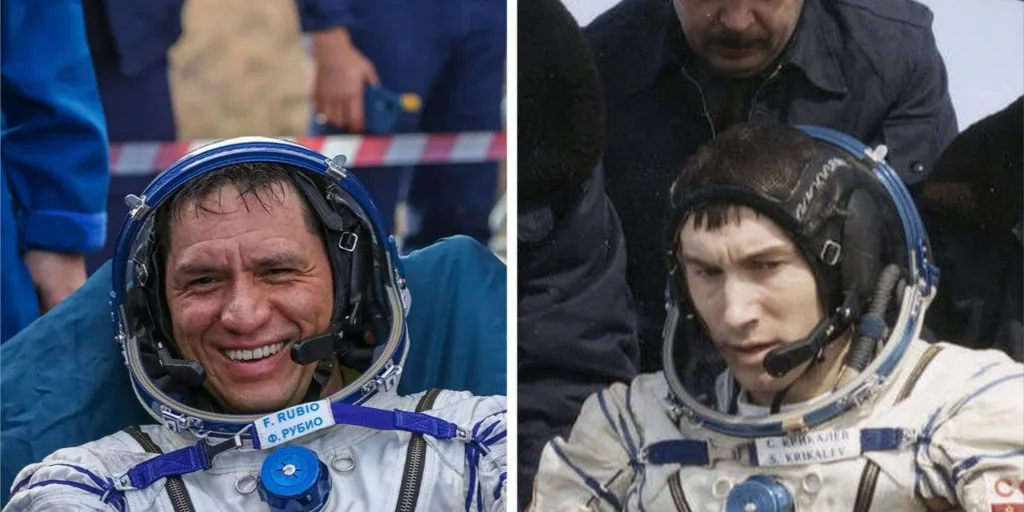other astronauts trapped in space

The case of Suni Williams and Butch Wilmore, NASA astronauts who remain trapped on the International Space Station (ISS) due to multiple malfunctions in the Starliner, the Boeing vehicle they are testing, was not the first incident of its kind that humanity has encountered in space.
Ever since space objects like the now defunct MIR or the current ISS have been operational, there have been tense situations that have led to unusual episodes that astronauts have encountered in orbit. Below are some missions that have been extended due to unexpected “failures.”
The last one stuck
Less than a year later, a similar situation to what happened to Suni Williams and Butch Wilmore occurred on the ISS. On December 14, 2022, as cosmonauts Sergei Prokopyev and Dmitry Petelin prepared for another spacewalk 400 kilometers above our heads, a spectacular white jet could be seen on a live broadcast taking off from the Soyuz MS-22 spacecraft, the Russian ship docked at the station, where Prokopyev and Petelin arrived from Kazakhstan with NASA astronaut Frank Rubio in September of that year. They had to return there, but the incident complicated matters.
That snowflake-like material was actually liquid from the probe’s cooling system, a vital component in maintaining the capsule’s temperature when the astronauts return home and have to reenter the atmosphere, where their craft can withstand temperatures of more than 1,600 degrees.
From there, a whole space soap opera unfolded, including more leaks of Russian spacecraft, the sending of a spare Soyuz, and the mission being extended from the planned six months to a year. “It was tough knowing that I had to spend another six months in space, away from my family. But I have colleagues in the military who are having missions extended in much harsher conditions, so I couldn’t feel sorry for myself,” Rubio explained at a press conference a month after his return, almost a year ago, in September 2023.
Cosmonauts who took off in the USSR and landed in Russia
But if there’s a movie story about being stuck in space, it’s the story of cosmonauts Sergei Krikalev and Alexander Volkov. The former arrived at the defunct Soviet space station Mir in May 1991, and the latter, along with Kazakhstan’s Toktar Aubakirov and Austria’s Franz Viehböck, arrived in October of that year. In principle, both would return within five months. But the collapse of the Soviet Union cut their plans short, and their futures literally floated in space.
The Austrian and Kazakh were able to descend a week after their arrival, but the Soviets were left waiting for orders. It was a tricky situation, however: they had flown to a country that no longer existed, and they had no idea of the implications. “It was something unexpected for us, we didn’t understand what was happening,” Krikalev himself recalled in the 1993 BBC documentary The Last Soviet Citizen (though the cosmonaut was never alone in MIR, he eventually became the most famous of the space duos, as he was responsible for communications with the ground). “With the little information they gave us, we tried to get the full picture.” Krikalev communicated with people in the West and with his wife, Elena Terekhova, who worked as a cameraman for the Soviet space program.
In fact, the cosmonaut could always return; however, this would mean leaving MIR abandoned. For him, this was a liability. For the newly formed Russian government, it did not matter much, since they had other concerns. Moreover, on October 25, 1991, Kazakhstan declared its sovereignty, which meant that the cosmodrome from which Krikalev’s relay was to take off was no longer under Russian control.
On December 25, 1991, the Soviet Union finally collapsed. Exactly three months later, Krikalev and Volkov returned to Earth. “It was very nice to return, despite all the hardships we had to endure, we were freed from the psychological burden,” the cosmonaut said.
And despite the odyssey, it was not Krikalev’s last visit to space: in 2000, he was part of the first crew to travel to the brand-new International Space Station, whose infrastructure has since become a symbol of cooperation between countries.
Italian Cristoforetti Takes Record Away from Suni Williams
Expedition 43 crew members Terry Virts (NASA), Anton Shkaplerov (Roscosmos) and Samantha Cristoforetti (European Space Agency) were not “stuck” on the ISS: their return ship did not suffer any failures. In this case, it was collateral damage from an incident on another ship, the loss of the Russian cargo ship Progress 59, which extended its stay a month longer than expected, to almost seven. “Its return date was delayed by four weeks to allow Roscosmos to investigate the cause of the loss of the unmanned cargo ship Progress 59 in late April.”
As it happens, Cristoforetti, who arrived with her crew in November 2014 and left the following June, took the record for the longest female stay on the ISS from Suni Williams herself, surpassing her 195 days in orbit.
